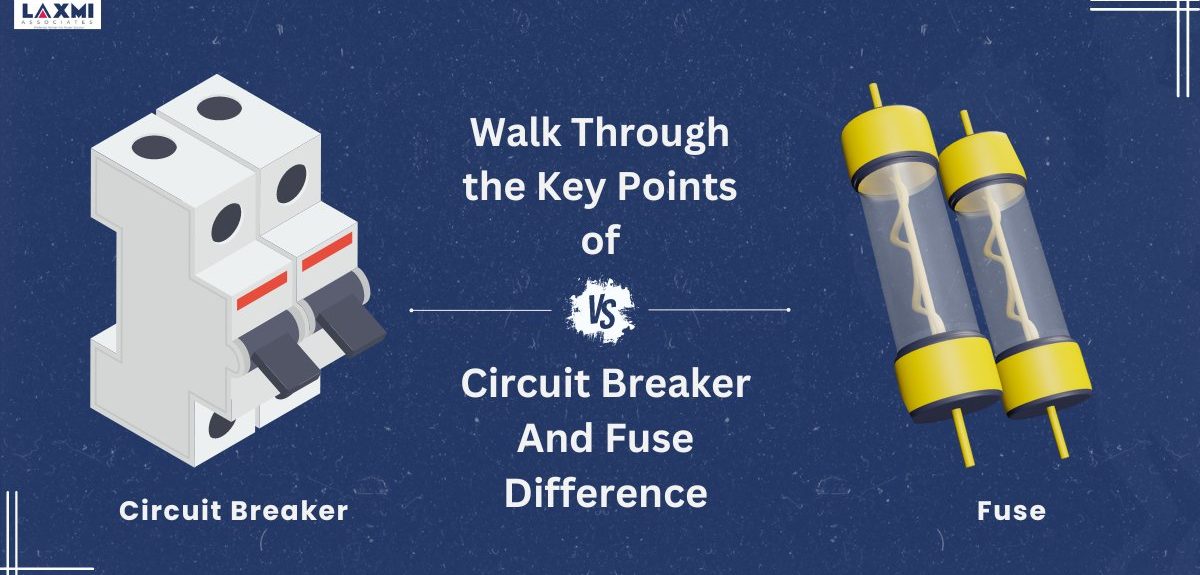Walk Through the Key Points of Circuit Breaker and Fuse Difference

It has been said that technology is dominated by Industrial and machine manufacturing. The process of the Industrial Revolution started in 1820 and marked a benchmark in Global History. The era changed the pace of social changes and economics which mechanized the development of electric grids, steel-making processes, and large-scale machine tools. Therefore, the key inventions and innovations accelerated the subtle practical production into the technological revolution. The important changes and innovations later opened the path for Circuit breakers, Fuse power- supply, and electrical devices. In recent years, the demand for eclectic power systems has flourished and has gone through a seismic shift and significant digitalization.
The article will help in educating you about the circuit breaker and fuse difference in depth and their unique advantages, working principles, and disparities to match your needs and make the right choice. However, both fuses and circuit breakers vital role in handling the surplus and inrush of the electric currents.
Circuit Breaker |
Termed as Modern Guardians |
Mechanism- Electromagnetic principle |
Can be reused multiple times |
Circuit breakers are relatively higher cost |
Fuse |
Termed a time-tested protection |
Mechanism- Electrical and Thermal principle |
The fuse is not usable |
These are mostly cost-effective |
Gujarat is leading the world in powerful electrical potential plants and the good news is that Laxmi Associates; owned by Dr. Aradhana Ray has become one of the renowned industrial leaders based out in Vadodara, Gujarat with one “Complete Power Solution” and benchmarks higher than the expectations.
Industrial Engineering has been a major contributor to techno-human advancement. Therefore, with these profound revolutions let me take the article further and make you understand What is Fuse?, How Does Fuse Work? and How Does a Circuit Breaker Works? You will come to understand the resettable nature of the Circuit Breaker and Fuse with additional safety features.
What is Fuse?
The acceleration process has brought an array of new tools and modern equipment and virtually shaped the industrial line. Now, let’s delve into What is Fuse? Fuse first came into knowledge in the year 1890 quenching the speed of the electric distribution system.
An electric fuse is an electromechanical product/ service that comes with a comprehensive and multi-disciplinary design to deliver usable electric components/circuits over current safely. It is a safe-guarded electrical element barrier between humans and electric circuits where electrons can flow.
Moreover, an electric fuse is a safety- a device that protects your valuable electrical equipment and appliances of high voltage like a Fridge, Hair Dryer, Washing Machine, etc from over-loading and preventing the flow of high electric current from causing desolation.
How Does Fuse Work?
As we are aware now Fuse is an electrical safety device that contains a piece of lustrous metal wire that heats up fast and then can melt easily to avoid mismatched and over-loading of your electrical appliances and electric current. So, the fuse is an essential electro-mechanical device for all the electronic components to prevent electrical hazards. Therefore, now let me take through an interesting threshold of How Does Fuse Work? The fuse is designed in such a way that it opens the gap within the closed electric- loop and breaks the circuit. The working principle of a current- interrupting electrical- mechanical device is based on the “ heavy heating and melting effect” of the thin wire present inside the circuit loop.
Moreover, in normal conditions, the intangible wire inserted in the electrical loop remains intact contributing electrical charges to the complete closed loop.
Therefore, before selecting any electrical fuse consider all the parameters related to voltage and current lowering the risk of dangerous and undesirable incidents and havoc.
What is Circuit Breaker?
Electrical power substations have become an important plethora in modern- grid infrastructures and powerful power distribution systems. At the core, we know that electric appliances are everywhere around us be it offices, residences, etc; therefore circuit breakers are categorized as protection systems and the first line of safe-guarded shields reducing the risk of electric faults and major electrical accidents. Additionally, to epitomize further; let us understand What is Circuit Breaker? This is an automatically operated proxy electrical switch that stops the flow of electricity to prevent the risk of major short circuits. It is also important to note that these safety devices come in various sizes and types depending on power distribution systems. So, circuit breakers are compact devices for thermal and magnetic protection with several models like single-poles, two poles, etc varying from residential to larger industrial areas.
How Does a Circuit Breaker Works?
The circuit breakers work with the tripping and switch mechanisms interrupting the flow of electricity when it detects any faulty condition. These electric circuit breakers provide more precise protection used in power distribution systems when the flow of electric current and charged particles transcends a definite threshold point. Now please let us quickly go through the operation mechanisms and understand that How Does a Circuit Breaker Works? I, therefore, request you to please go through the article below to understand the mechanism of the Circuit Breaker
The thermal switching electro-mechanical device works on two different protection which are terminal-magnetic and short-circuit mechanisms considering the electrical characteristics and force. For example in power generation plants; circuit breakers prevent the flow of charge to high-voltage equipment like dollar cells, PLCs, and other sub-stations. The breaker wire trip energizes and opens the breaker apart from each other when the pressure is applied to the trigger and cannot handle the excess electrical load.
The circuit breaker consists of bimetallic stripe wire and GFIC( Ground- fault circuit interrupter) to monitor the current precisely preventing electrocution. Let me also take you to the newly developed electrical circuit AFCI( Arc Fault Circut Interrupter) promptly monitoring the arc form of electrical wave to detect changes and fluctuations in wave patterns.
Circuit Breaker Vs Fuse
Electrical safety is a general practice to deal with potential dangers, arc flash, or electrical deaths. As we noted both circuit breakers and fuse are critical and essential components when it comes to appropriate protective devices. It is sometimes difficult to select between Circuit Breaker Vs Fuse and therefore, make an appropriate selection. Both electrical devices are important; likewise, there are some differences between Circuit Breakers and Fuse and how they differ from each other.
- Fuse– A fuse is significantly a basic and traditional technology to protect against high wave current and electrical charges. Moreover, the threshold of the fuse is extremely difficult to maintain under maximum pressure and electric current. The fuse ratings come with 3A, 5A, and 13 A ratings used for reputed environments. They are jerry-rigged basic safety devices to protect electrical types of equipment manually by a person. These are simple electrical safety devices that offer ease of installation.
- Circuit Breakers- This is a most essential modern electrical component for any ideal situation to protect electro-digital appliances from overcurrent. The circuit breakers are designed in copper bars with unique advantages to detect the high and low electric pressure/ current and are considered to be the most reliable option if compared with modern solutions. Circuit breakers will immediately disconnect the power by using a thermal magnetic combination to isolate the over-loaded portion. Moreover, this electro-thermal magnetic device uses solenoids in down-streaming the power cords.
As both these electric devices are technically used to identify potential electric- wiring; therefore, please acknowledge all the elements, characteristics, and parameters before making any selection.
The heart of today’s technology is Artificial Intelligence and Machine Learning; similarly, energy power supply technology has become EAAS-
Moreover, in this article, we discussed circuit breaker and fuse difference in the abyss including the overview and functioning of both the electrical components. We also came to know that Laxmi Associates based out in Vadodara is providing the best and one-stop comprehensive energy management solutions across the borders.
Therefore, in conclusion, I would like to say that with innovations electrical power systems are changing; so to sustain your struggle visit https://laxmiassociates.in/ immediately and book your electrical equipment according to your specifications at an affordable price.

